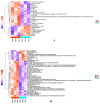Unravelling the Signature Follicular Fluid Metabolites in Dairy Cattle Follicles Growing Under Negative Energy Balance: An In Vitro Approach
- PMID: 39684341
- PMCID: PMC11641226
- DOI: 10.3390/ijms252312629
Unravelling the Signature Follicular Fluid Metabolites in Dairy Cattle Follicles Growing Under Negative Energy Balance: An In Vitro Approach
Abstract
The astringent selection criteria for milk-oriented traits in dairy cattle have rendered these animals prone to various metabolic disorders. Postpartum lactational peak and reduced feed intake lead to negative energy balance in cattle. As a compensatory mechanism, cattle start mobilizing fat reserves to meet the energy demand for vital body functions. Consequently, diminished glucose concentrations and elevated ketone body levels lead to poor ovarian function. The impaired follicular development and subpar oocyte quality diminish the conception rates, which poses significant economic repercussions. Follicular fluid is integral to the processes of follicular growth and oocyte development. Hence, the present study was performed to identify potential alterations in metabolites in the follicular fluid under in vitro culture conditions mimicking negative energy balance. Our results revealed nine distinct metabolites exhibiting differential expression in follicular fluid under negative energy balance. The differentially expressed metabolites were predominantly associated with pathways related to amino acid metabolism, lipid metabolism, signal transduction mechanisms, and membrane transport, alongside other biological processes. The identified signature metabolites may be further validated to determine oocyte fitness subjected to in vitro fertilization or embryo production from slaughterhouse source ovaries.
Keywords: dairy cattle; follicular fluid; metabolites; negative energy balance.
Conflict of interest statement
The authors declare that they have no conflict of interest.
Figures








Similar articles
-
Preovulatory serum estradiol concentration is positively associated with oocyte ATP and follicular fluid metabolite abundance in lactating beef cattle.J Anim Sci. 2022 Jul 1;100(7):skac136. doi: 10.1093/jas/skac136. J Anim Sci. 2022. PMID: 35772749 Free PMC article.
-
Preovulatory follicular fluid and serum metabolome profiles in lactating beef cows with thin, moderate, and obese body condition.J Anim Sci. 2022 Jul 1;100(7):skac152. doi: 10.1093/jas/skac152. J Anim Sci. 2022. PMID: 35772755 Free PMC article.
-
Lipopolysaccharide-binding protein in follicular fluid is associated with the follicular inflammatory status and granulosa cell steroidogenesis in dairy cows.J Reprod Dev. 2024 Jun 1;70(3):169-176. doi: 10.1262/jrd.2023-104. Epub 2024 Apr 19. J Reprod Dev. 2024. PMID: 38644218 Free PMC article.
-
Development of the dominant follicle: mechanisms of selection and maintenance of oocyte quality.Soc Reprod Fertil Suppl. 2007;64:141-63. doi: 10.5661/rdr-vi-141. Soc Reprod Fertil Suppl. 2007. PMID: 17491145 Review.
-
An overview on how cumulus cells interact with the oocyte in a condition with elevated NEFA levels in dairy cows.Anim Reprod Sci. 2019 Aug;207:131-137. doi: 10.1016/j.anireprosci.2019.06.003. Epub 2019 Jun 4. Anim Reprod Sci. 2019. PMID: 31227325 Review.
References
-
- USDA Development of the Average Annual Milk Production Per Cow in the United States Since 1924. [(accessed on 19 September 2024)]; Available online: https://quickstats.nass.usda.gov/
MeSH terms
Grants and funding
LinkOut - more resources
Full Text Sources
Research Materials

